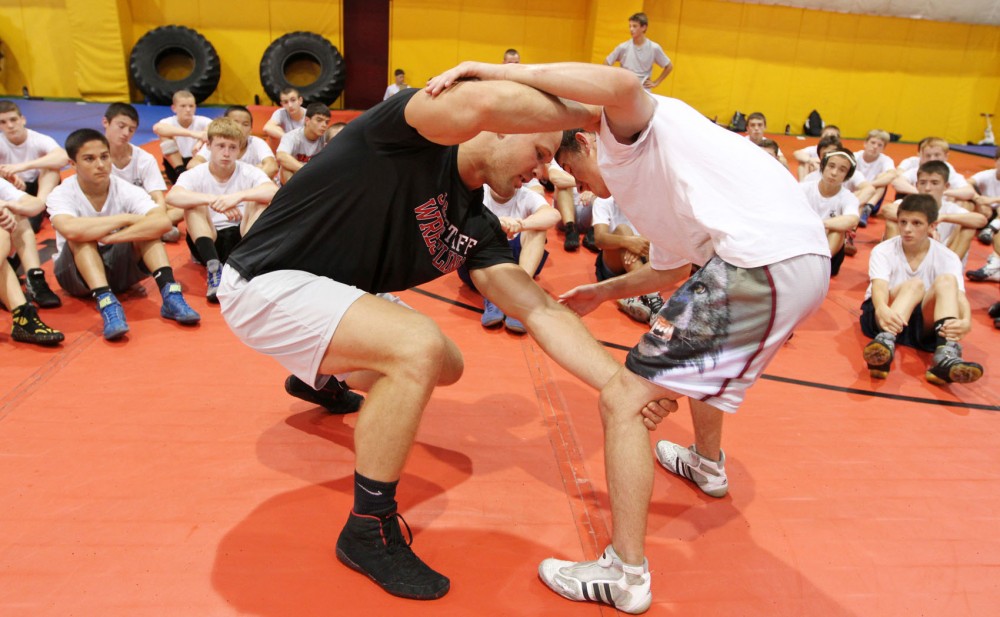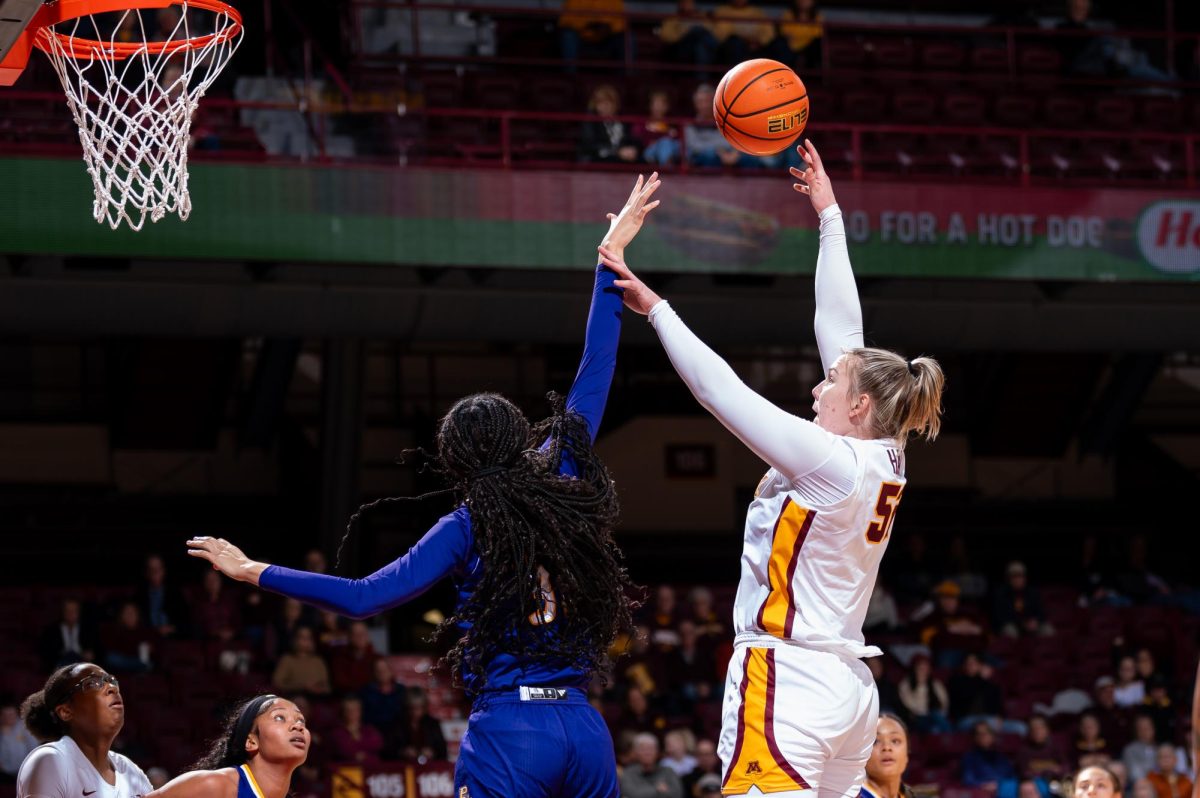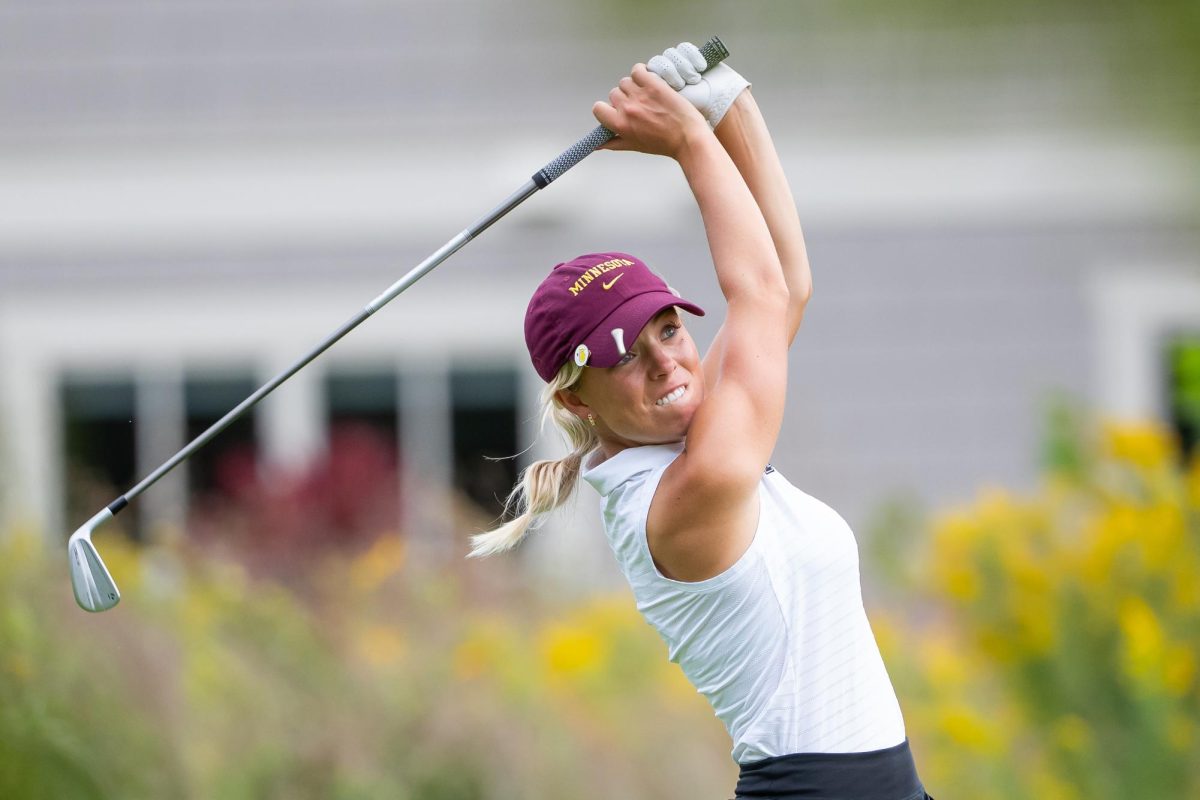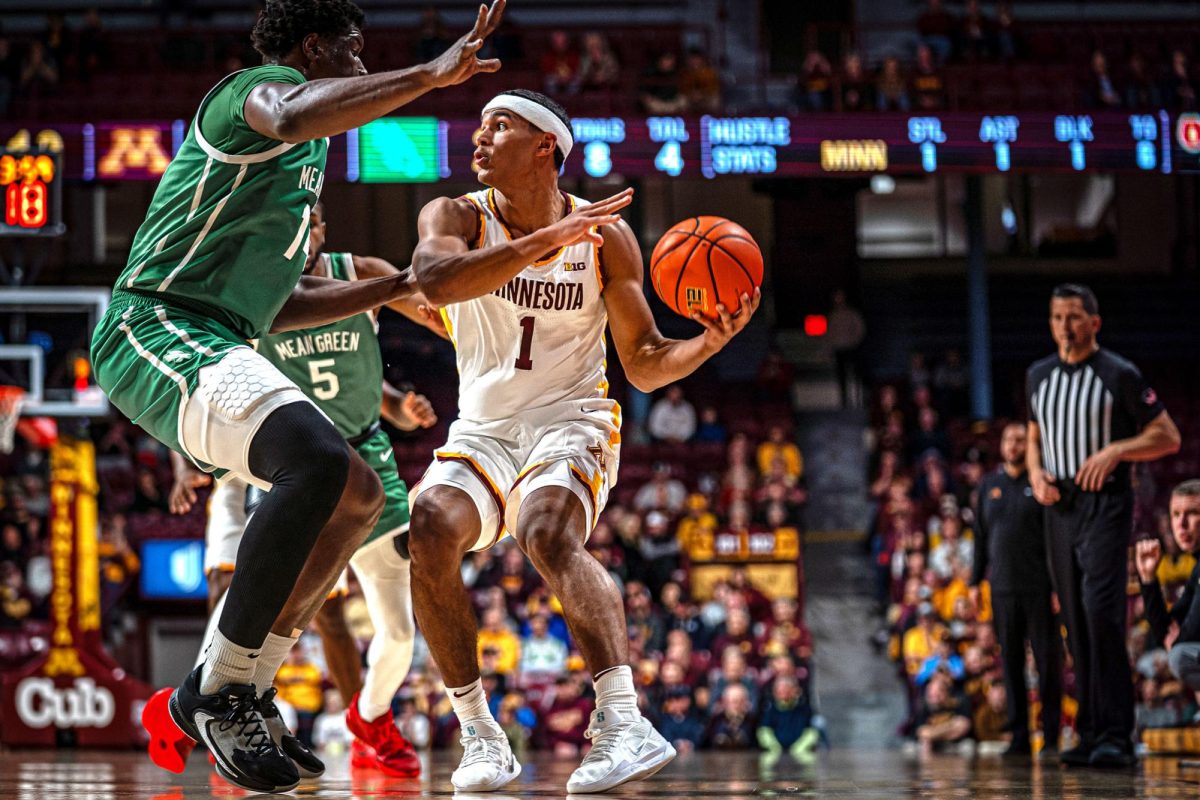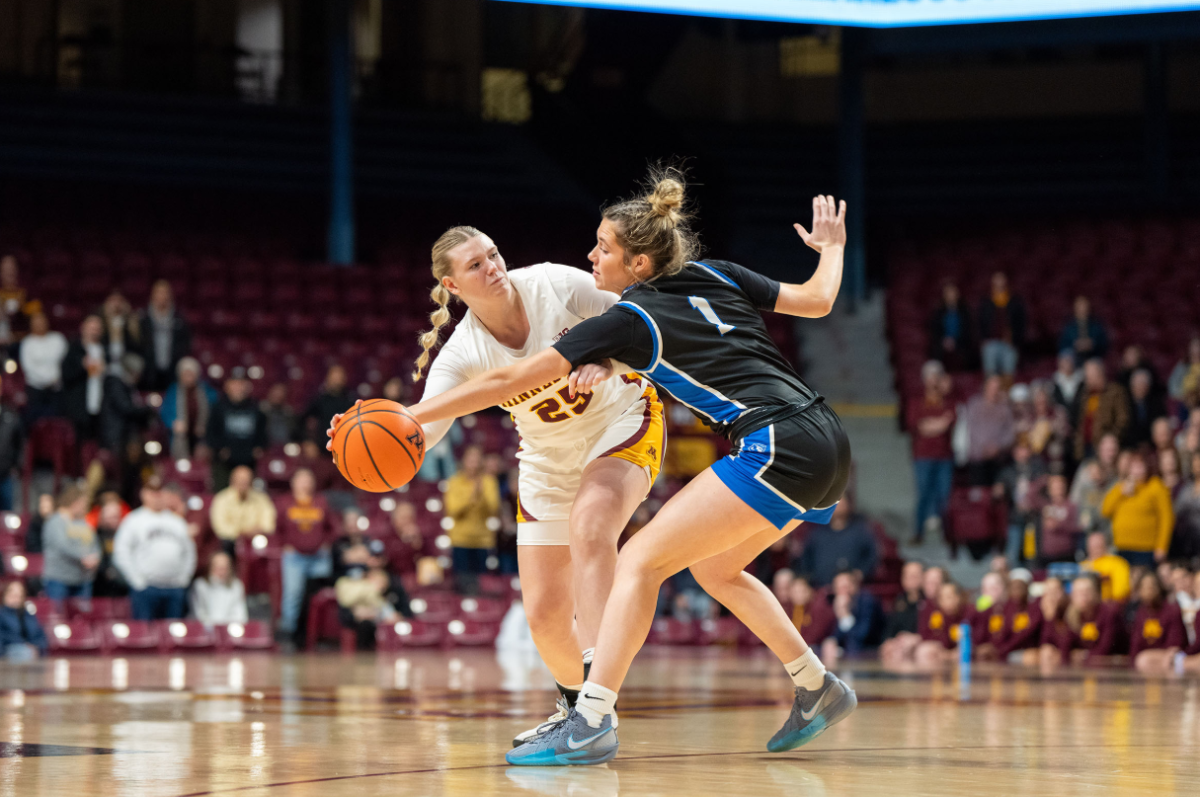Carter Page had never cried during a workout before.
“It’s so painful sometimes,” Page said. “But getting through it is the best feeling in the world.”
Page, 16, reached the Virginia state wrestling final his freshman season as a rookie to the sport. However, after a loss in the championship and a poor effort his sophomore year, Page said he needed to do something different.
“I had to make a change, so I came here,” he said.
The high school junior chose J Robinson’s Intensive Wrestling Camp, a four-week wrestling boot camp in July, housed in the University of Minnesota’s Sanford Hall. About 300 athletes, ages 14 to 18, come from around the country to the University’s East Bank to hone their skills on the mat.
Gophers wrestling coach J Robinson organizes nearly 30 coaches, half of whom are University wrestlers, and 10 trainers to switch in and out on any given day, to run workouts seven days a week on campus at places like the Gibson-Nagurski Football Complex.
“We’re the only people going beyond the 10-day camp,” said Ty Eustice, the camp’s director of operations. “No one is willing to or has the structure to pull off what we pull off.”
The camp’s rigor sets it apart. Eustice said the majority of wrestling camps are technique-based and aren’t meant to get the participants in prime wrestling condition.
“We really try to get the point across that if you’re not 14, you’re probably not ready for the camp,” Eustice said. “I’m not even sure most 18-year-olds are ready.”
‘The shirt’
As early as 6:30 a.m. on any July weekday, groups of campers dart through Dinkytown’s morning rush hour. The sidewalks appear to be dressed with white shirts, a last name etched in black marker on the back of most.
“I just try to imagine myself on the other side of this,” camper Erick Haney said after finishing his morning run.
Haney, 15, traveled with his twin brother from Nevada to spend four weeks of his summer in Minneapolis. He wakes up at 6:15 a.m., and his workouts aren’t usually done until late evening.
“While it’s a lot more than I expected, I can’t wait to reap the benefits,” Haney said.
As the campers finish their morning run, they rejoin their water bottles and bags on the lawn of Sanford Hall. The majority of them collapse in the grass from exhaustion before they can get a drink.
Eventually, they file into Sanford’s dining hall. Even though the work is temporarily done, Haney’s focus remains.
“I can’t wait to try the 15-mile marathon,” he said as he ate breakfast. “If you complete it, you get 100 points back and a more likely shot at the shirt.”
“The shirt” is a reward from the camp — but finishing the 28 days doesn’t guarantee it.
Robinson designed and runs a points system that gives the campers approximately 1,000 points each at the beginning of the four weeks. If a camper can tough it out and hold onto two-thirds of his points, he’ll earn a T-shirt that denotes his successful completion of the camp.
Eustice said campers can gain or lose points for a variety of things, but it’s based on tangible efforts not skill level. Forgetting one of any number of items — water bottles, wrestling shoes, backpacks — will lose a camper points. If a camper shows up anywhere late, he loses points.
“Kids of course get wrapped up in it,” Eustice said about “the shirt.”
“But it’s about teaching them to do the right things, being responsible for themselves.”
Held on the last day of camp, the 15-mile run is one of a few length increments available. It’s the farthest a camper can choose to go, and it comes with a high points reward if completed.
Intensive wrestling
“No-nonsense,” one camper said about the camp.
“Military,” said another.
“I don’t want excuses,” reads a Robinson-camp sign hanging in a lobby of Sanford Hall. “I want you where you’re supposed to be, when you’re supposed to be there and with what you need.”
A bulletin board in the lobby of each floor of Sanford Hall has about 15 signs ranging from a “Thought of the day” to one that bluntly answers the most basic of questions.
“What time is practice?” the sign reads. “Read the schedule,” it answers.
Eustice said the structure takes some warming up for some campers, but most eventually buy into it.
“People find out things about themselves at this camp,” he said. “A couple days in kids swear they won’t be able to do it, but here we are, and I see the same kids two weeks later.”
After a morning run, campers get into groups of about 20 and are led through weight training and technique sessions by an instructor before wrestling each other in the afternoon.
Half of the Gibson-Nagurski complex’s indoor football field is blanketed in wrestling mats, the sides covered with water bottles, gym bags and trainers’ tables.
“This camp is very intense,” trainer Janese Evans said. “It’s a unique opportunity for us as medical staff as well — rarely do we see and treat this many acute injuries as they happen.”
Evans, 22, is working on her master’s degree in athletic training at Saint Louis University in Missouri. She finds time to fill in at camps like Robinson’s throughout the summer to practice her craft.
Rolls of athletic tape and bottles of disinfectant accompany new crutches, still in the wrapping, as Evans tapes up a camper’s swollen ankle.
Trainers must check for concussions, dehydration and weight fluctuation on a regular basis. If a camper loses too much weight, he can’t work out until it has stabilized.
Although campers come to the trainers for aid, the intensity doesn’t simmer at their table.
“50 push-ups if we can’t read your name,” a sign on the table reads.
‘It changes people’
Last week, an additional 100 kids occupied dorms in Sanford Hall.
“We came because J [Robinson’s] camps are known for their mental toughness,” said Jarrett Lewis, 40, of Jefferson, Wis., whose son Hunter has been wrestling since kindergarten.
Hunter wanted to join the intensive group, but he’s only 11.
The only option he had was to attend Robinson’s five-day technique camp, a shortened form-based session for younger wrestlers that was held July 8-12 during the intensive camp.
“It’d be a great building block,” Jarrett Lewis said about the intensive camp. “He really wanted the challenge [of the intensive camp], but he’s just too young. He’ll have to wait a few years.”
Robinson’s system holds camps in Oregon, Pennsylvania and New York during the summer, but Minnesota’s has gained notoriety because it’s the only longer, 28-day session available.
Robinson, who has coached a prominent wrestling program at Minnesota for 27 years, uses his own Gophers wrestlers to help coach the camp, which ends July 27.
“It’s basically a summer job,” said camp instructor Alex Daugherty, a sophomore wrestler at Minnesota. “Our coach kind of pushes us to do it, but we’re here for the kids. Plus, it helps keep us around the sport, helps us constantly get better.”
With the camp’s extensive network and Robinson’s national recognition from coaching, serious wrestlers and their families from across the country are willing to pay thousands of dollars to spend a month training with Robinson and his staff.
“My high school coach in Nevada told me it changes people,” said Hayes, the camper. “So I came. I’ve seen a lot of kids drop out, but that’s not for me. I’ll make it through this.”


